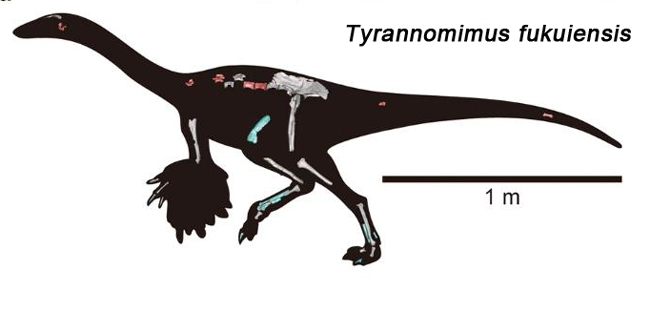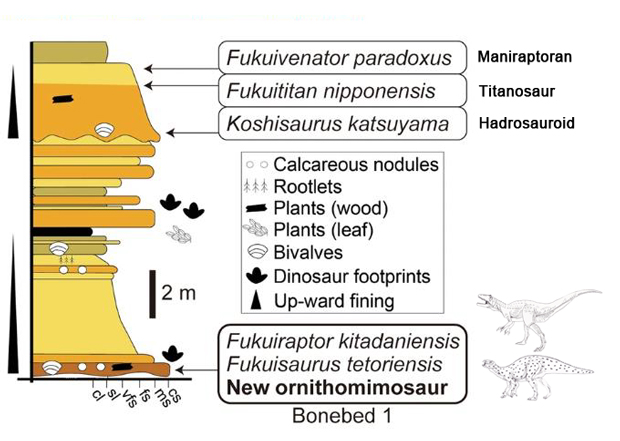A new species of Japanese dinosaur has been announced. The dinosaur, classified as a deinocheirid and therefore distantly related to the bizarre Deinocheirus has been named Tyrannomimus fukuiensis.
Fragmentary fossils representing a type of ornithomimosaur had been excavated from the Kitadani Dinosaur Quarry (Fukui Prefecture, Japan) since 1998. The remains represent several individuals, but the fossil bones show identical anatomical traits leading palaeontologists to conclude that a single, new taxon was present.

Tyrannomimus fukuiensis
Phylogenetic analysis indicates that T. fukuiensis is the earliest definitive deinocheirid described to date. Its discovery will help scientists to better understand the evolution and dispersal of early ornithomimosaurs. Tyrannomimus is estimated to have had a body length of around 2.5 metres. It was probably feathered.

The bonebed from which the fossil material was excavated is thought to be around 120 million years old (Aptian faunal stage of the Cretaceous). The Kitadani Dinosaur Quarry has yielded several different types of dinosaur. The stratum from where the Tyrannomimus was excavated is associated with two other dinosaurs – Fukuiraptor (possible megaraptoran) and the herbivorous Fukuisaurus (hadrosauriform).

Kitadani Dinosaur Quarry Bonebed 1 Biota
Both Fukuiraptor (F. kitadaniensis) and Fukuisaurus (F. tetoriensis) are found at the same level as Tyrannomimus fossil material. This suggests these dinosaurs were coeval. The palaeoclimate of the lower portion of the Kitadani Formation is believed to have been a humid, tropical ecosystem. Slightly younger geological deposits, yield abundant conifer fossils indicating that the climate may have become drier.

The picture (above) shows Fukuiraptor and Fukuisaurus figures. These replicas are part of the CollectA range of prehistoric animal figures. Fukuiraptor is in the CollectA Age of Dinosaurs range, whilst the 1:40 scale Fukuisaurus is found within the CollectA Deluxe range.
CollectA Age of Dinosaurs: CollectA Age of Dinosaurs Prehistoric Life.
CollectA Deluxe Models: CollectA Deluxe/Supreme Scale Models.
Not a Tyrannosauroid
The genus name translates as “tyrant mimic”. The ilium shows similarities to the hip bones of tyrannosauroids. Indeed, prior to its formal scientific description this dinosaur was thought to be a member of the Tyrannosauroidea.
The identification of Tyrannomimus fukuiensis as an ornithomimosaur has implications for a dinosaur found in Portugal. Aviatyrannis jurassica was named and described in 2003 (Rauhut). It is estimated to have lived around 155 million years ago (Late Jurassic). Aviatyrannis was thought to represent a tyrannosauroid. However, analysis of the bones of Tyrannomimus with Aviatyrannis revealed similar characteristics. As such, Aviatyrannis may represent an ornithomimid too. If this is the case, then Aviatyrannis jurassica, may represent the earliest ornithomimosaur described to date.
If Aviatyrannis is confirmed to be a member of the Ornithomimosauria, then it significantly expands the temporal and biogeographic range of these theropod dinosaurs.
Everything Dinosaur acknowledges the assistance of the open-access scientific paper in the compilation of this article.
The scientific paper: “New theropod dinosaur from the Lower Cretaceous of Japan provides critical implications for the early evolution of ornithomimosaurs” by Soki Hattori, Masateru Shibata, Soichiro Kawabe, Takuya Imai, Hiroshi Nishi and Yoichi Azuma published in Scientific Reports.
Visit the Everything Dinosaur website: Everything Dinosaur.






Leave A Comment